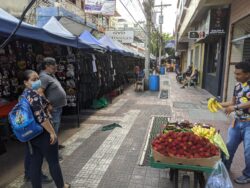Latin America’s Zoning-free Urbanism
Spontaneous commerce, dense settlements, high-rises, and seemingly non-existent zoning dominate the urban realm.
Early into my Latin America trip—which is part of a 1.5-year journey through the Global South—I stopped in Monterrey, Mexico. One area there gave me a glance into the spontaneous urbanism I would see regionwide. Independencia, south of downtown, is considered dangerous, but didn’t seem bad while I was walking through—and had fascinating land use. Seemingly devoid of zoning, the residential area had every last use mixed in: auto shops, small factories, salons, grocery marts, etc. Some businesses were literally run from people’s homes, such as a guy selling hot dogs from his driveway. The neighborhood, despite being low-rise, was hyper-dense, with nary a vacant lot.
This is different from what we’re used to in America. Most cities in Europe and the U.S. have strictly-controlled land use, regulating what can be built where, regarding height, use, parking, aesthetics, positioning, and more. Note any U.S. municipal general plan, and one finds a simplistic document putting broad designations over large portions of the city.
But across LatAm one finds many heights and purposes, including much construction that goes where it’s technically not supposed to. LatAm cities do however have land use regulations, so what explains the contradiction?
It’s partly that governments have no choice but to liberalize, given the demand pressures. Latin America is “the most urbanized region in the world,” according to the Atlantic Council, with 80% of the populace residing in cities. Migration from rural to urban settings occurs rapidly, but without the impending suburban dispersion that occurs in the U.S.
Cities respond by dramatically altering their built form. Panama City, Medellin, São Paulo and Santiago are all cities with massive amounts of high-rise construction.
While this verticality usually concentrates in certain areas, it spreads to others that one would not expect. I found in wealthy, low-rise gardenesque neighborhoods, developers were tearing down single-family homes to build towers. This would be a non-starter in similar U.S. neighborhoods, squelched by restrictive zoning and historic preservation laws.
Some critics bemoan this alleged overdevelopment, and there are in fact some zoning laws that exist in such areas. But the laws are often flouted—a product of ignoring or bribing one’s way out of them.
Like with what I saw in the poor Monterrey neighborhood, there is extreme use mixing even in rich ones. In Medellin’s Nogal area, the hotel where I stayed, despite being near single-family residences, had a gym and coffee shop at floor level.
Another esoteric building format I saw in LatAm are residential structures where retail goes multiple stories up. Again, this is largely non-existent in the U.S.

But LatAm’s truly unzoned order is found within informal settlements. Brazil’s favelas, for example, are typically built illegally on hills by newly city-bound rural peasants. There is extremely little space between homes, with narrow alleyways constructed based on cooperation between landowners. New structures are built in, up and around existing ones, via gradual construction. Because many residents are unemployed sole proprietors, the areas are full of little businesses operated from homes, carts or small storefronts, leading to intense saturation.

But lack of zoning in favelas (and similar informal settlements throughout LatAm) goes hand-in-hand with lack of general rule of law. Favelas have consistently struggled with high crime and gang control. They generally don’t have well-established property rights—in fact, the lack of property demarcation fuels violence. Hernando de Soto writes in The Mystery of Capital that bribery is a huge tax in these areas, at the hands either of local mafias or government officials.
These “invasions” (as they’re colloquially called) typically occur on virgin government land. But often smaller informal settlements come to formalized areas. For example in central San Pedro Sula, Honduras, merchants set up retail tent encampments right on streets, sidewalks and alleys. This is unsurprising, given the business climate: as the World Bank notes, “obtaining a construction permit in San Pedro Sula requires 17 procedures, takes 112 days and represents a cost of 5.3% of the warehouse value”—and this is before factoring for Honduras’ notorious corruption. So, frustrated entrepreneurs are driven into informal street commerce, and interestingly, this is tolerated.

When my San Pedro driver took me to an upscale area west of the centro, I found a similar motif. Across the street from a new luxury condo project, a small illegal encampment had been built along a riverbank.
It’s not entirely accurate to call LatAm “zoning-free”—although codes can be nebulous even for formal areas. A better term is “extralegal”, as large segments of the populace respond to institutional barriers by building anarchic guerilla urban typologies in or around formal spaces.
Ultimately, this lack of enforcement means Latin American urbanism looks chaotic, especially to U.S. observers used to central planning. But it’s functional: people down the socioeconomic ladder can still access housing, transport, and commerce close to opportunity. That can’t always be said of U.S. cities.
All images credited to Scott Beyer.
Catalyst articles by Scott Beyer | Full Biography and Publications
